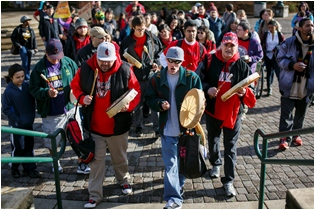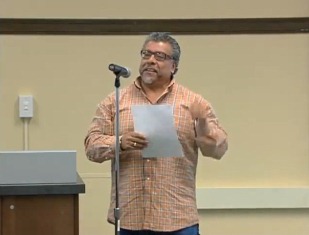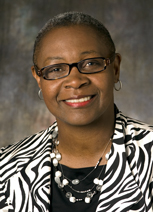 The Native American student body led a protest of |
A recent decision to discontinue the contracts of three popular administrators and restructure the University of Oregon's diversity office has angered many students and community members.
"As a minority on campus it's getting really old playing this game of blindside the minority service," says Tyree Harris, a UO student and former editor of the school's campus newspaper, The Daily Emerald.
He and other students are concerned that the new, broader approach will take away resources to address the needs specific to their ethnic backgrounds.
During the campus's winter break, an article appeared in the Register-Guard, reporting that student and local community organizations were blasting the decision to discontinue the contracts of Carla Gary Ph.D., Emilio Hernandez Ph.D. and Tom Ball Ph.D. in the Office of Equity and Inclusion (OEI).
The three administrators have been pillars in UO's Black, Latino and Native American communities, respectively.
In addition to discontinuing these contracts, the OEI also announced that it would be restructuring its approach to diversity with a new "distributed model." This model would shift accountability on issues of equity, inclusion and diversity from a sole assistant vice president to the entire university.
The President's Office deferred all questions to Yvette Alex-Assensoh Ph.D., the Vice President of the OEI, when asked for comment on this story.
According to an email interview with Alex-Assensoh, "A distributed model simply says that we need people from different backgrounds and with different expertise positioned throughout the organization. In this way, we move from having one person responsible for representing the multiple interest of a diverse group in one unit of the university to an organization that is accessible to under-served populations in multiple ways."
She wrote that she is not allowed to comment on what will happen to the administrators after their contracts expire because those are "personnel matters".
History of Diversity Issues

|
UO has had its share of controversy when it comes to diversity. Some buildings, such as Friendly Hall, are named after Ku Klux Klan members who donated to the school, in some cases, over a century ago (Watch a video discussing some of this controversial history here).
The OEI (originally known as the Office for Institutional Equity and Diversity) was created in 2004 as a result of a settlement in a discrimination lawsuit filed by a former university employee. In the last couple of years, the firing of former UO President Richard Lariviere, who was well regarded for his outreach to minority groups, and the restructuring of the former Office for Multicultural Academic Success (OMAS), caused a number of student protests.
The most recent changes have rekindled many of these tensions.
"Just to have someone around the campus to say 'Carla works at the university' was big for me and others," he says. "Just like Lyllye Parker when she worked at OMAS. Thousands will tell you she was essential."
Parker was an advising coordinator and member of one of Eugene's leading African-American families. She was well regarded by many and even had the UO Women of Color Conference named in her honor.
When OMAS was transformed into the Center for Multicultural Academic Excellence (CMAE), she lost her position. Students protested the change, citing a lack of information and no student input in the decision making process (UO Truth emerged and documented much of this resistance).
Lyllye Parker speaks on OMAS restructuring. (Part 2. Part 3.)
Culturally Insensitive?

|
Following the publishing of the Register-Guard article, the UO Native American student body, with help from other student groups and community organizations, organized and carried out a protest on Jan. 7, the first day of classes for the winter term. The group is also circulating a petition for students to sign in support of Gary, Hernandez and Ball.
According to Shay Macy, a representative for the Native American student body, Ball was irreplaceable.
"He represents the Native American student body," she says. "He also is a strong member of our extensive communities."
Macy notes that Ball was essential to recruiting and retention, as well as directly connecting with Indians from the Reservations.
Ada Ball, a representative of the Native American Student Union and Tom's niece, says the move was culturally insensitive.
"Now they want one person at the VP level to oversee everything," she says. "We feel that person wouldn't be able to adequately address all our needs."
Harris, who is quick to say the university was far from perfect in its previous diversity efforts, adds that the timing was particularly concerning.
"It's not like we were doing such a great job beforehand but cutting out those services and doing it over winter break when nobody saw it coming doesn't send out the right message," he says. "I don't feel like making these changes in this fashion is going to generate the positive community that they claim to want the University of Oregon to be for people of color.
"The first time it happened I was frustrated. But for it to happen the exact same way, it's so bad it's almost funny."
A Lack of Communication?

|
While his predecessor had a reputation for reaching out to communities of color, President Gottfredson has cast a different impression in the eyes of some students.
Ada Ball says that communication between the President's Office and the Native American community is lacking. She says she has yet to meet the President this school year and has only seen him once at a community parade.
In response to allegations that she and the President's offices haven't done enough outreach with communities of color, Alex-Assensoh notes that she arrived on campus in August of 2012, the same time as President Gottfredson.
"While I cannot speak for what has happened in the past, I will happily affirm my respect for community members as well as my colleagues at OEI and my sincere interest in engaging in dialogue on the issues that I am at liberty to discuss," says Alex-Assensoh.
In an effort to create dialogue between the OEI, students and other concerned communities, there will be three town hall meetings at UO this week. Alex-Assensoh also spoke directly to the BSU on Wednesday evening.
She emphasizes that the OEI wasn't responsible for the timing of the announcement about the changes.
"The ongoing restructuring of OEI began in October 2012, not over the break," writes Alex-Assensoh. "The local newspapers chose to write about some of the issues during that period."
She goes on to say that a year-long leadership training program with the American Council on Education taught her that "Restructuring is a constant on college and university campuses. Much of the restructuring goes on without media attention and, as a result, the public is often not aware of it. However, given the enormity of changes in our society as well as our State, restructuring at OEI and at other places on campus must be done to make sure that we are responsive to the current needs of our students, faculty, staff and community members around the State of Oregon and beyond."
A "Distributed Model"

|
While the communication disconnect has rubbed some students the wrong way, many are even more concerned about what the new "distributed model" entails.
"I think the struggles that people go through racially are very unique from the struggles people go through with sexual identity, or being a non-traditional student or having a disability," says Harris. "They're very different and I don't think it's fair to lump all those issues together because, as we're going to see, it's going to throw that pretty much under the bus and no one is going to look at that anymore."
Alex-Assensoh says that while a focus on diversity is a good first step, it's not sufficient in itself.
"Diversity focuses primarily on ensuring that people of different backgrounds are present in an organization, but it does not focus intentionally on whether or not people have voices in the decisions, policies and processes that are significant in bringing about change," she says in her email statement.
According to Alex-Assensoh, the OEI is trying to put in place a more focused approach that will be led by directors rather than assistant vice presidents, which is what they've done with other OEI units.
"In this sense, the organizational changes at OEI are not demotions, but simply an effort to provide more focused leadership to programs and policies, and to align our OEI administrative unit with the rest of the organization," reads her statement.
"Additionally, a focus on inclusion builds on diversity by saying that it is not enough to bring people of different backgrounds into the university, but we must also make our hiring practices, our review processes, our budget models, our teaching curriculum and other things inclusive in ways that empower people from different backgrounds to contribute their talents, skills and expertise in ways that make a lasting difference."
Alex-Assensoh wouldn't comment on whether the administrators did anything to earn the discontinuing of their contracts, once again citing "personnel matters". However, during her meeting with the BSU, she emphasized that the UO was one of the few campuses in the country operating with what she saw as an outdated diversity outreach model.
Where Will Students Go?
 Alex-Assensoh's office is situated in UO's Johnson Hall |
Alex-Assensoh notes that people are bound by relationships, which makes the process of change hard for some to accept.
Many students expressed a level of intimacy they felt with the administrators and wondered what will fill that void in the midst of the restructuring.
"Dr. Gary is our friend and ally," reads an email statement from Olivia Manwarren, UO Black Student Union (BSU) co-director. "She has been a strong and tireless advocate for African American students in and outside of the Black Student Union. Dr. Gary makes the U of O feel safer for us as students, and makes us feel welcome here on campus."
Ada Ball also raises the issue of operational effects, pointing out that Tom Ball has had budgetary authority over the Many Nations Longhouse, a resource for Native Americans to meet and discuss issues pertaining to their lives on campus. Ada Ball worries that, under the new model, the OEI will put budgetary authority in the hands of someone who doesn't have the same intimate connection with the Native American community.
In response, Alex-Assensoh says there will be people in the OEI and other places at the university to discuss these issues, but didn't specify beyond that.
She says there is a plan to expand the services OEI provides, as well. One example, Alex-Assensoh gave was the planned expansion of the Opportunities Program, which is designed to go into community settings and engage with families to recruit their children for the UO. This program is already present in the Native American and Latino communities and she says she wants to expand it to Black, Micronesian and first generation communities. Alex-Assensoh emphasizes that the change is designed to fit the needs of students.
However, Ada Ball suggests that this restructuring doesn't take students' views into account.
"We understand that part of the reason for Tom's position is the unique need for him at this school," she says. "We feel that by having him in this position, it gave us strength while we're at this school. It was seen as something to aspire to."
Harris echoes these sentiments when he describes his relationship with Gary.
"I think Carla is one of the few people on campus who keeps track of what I'm doing," he says. "She's someone where if I was having a problem I could reach out to her and she would be there for me. We've always talked about plans. Just a good person to have around even if I didn't use the resources in the traditional way the university would've wanted you to."
A Different Approach

|
Despite sentiments from students and community members suggesting the administrators were doing a good job, Alex-Assensoh says the restructuring has nothing to do with budget concerns.
The Oregon House voted in 2011 to cut 11 percent of the budget for the Oregon University System for 2011-2013. Later that year, the UO approved pay raises for 300 administrators, ranging from five to 30 percent (This decision would ultimately factor into the firing of Lariviere).
Although she emphasized the expansion of services and new hires in OEI, Alex-Assensoh couldn't say whether the restructuring would create a net gain of jobs. She says the talks are ongoing on the number of director-level positions.
In comparison, the University of Washington (UW) sustained a 32.5 percent cut to its budget for 2011-2013. However, it recently announced the grand opening of its new Samuel E. Kelly Ethnic Cultural Center, which will house the 70 student organizations for people of color. It will also hold programs and feature a theater.
In addition, UW also renovated its Husky Union Building (HUB), which houses student of color commissions and a lounge area for students that engage with these groups.
To contrast, culturally specific student unions are housed in a hallway in the basement of the UO's Erb Memorial Union (EMU) and OEI units are dispersed throughout different buildings around campus.
UW has a total enrollment of 42,570 compared to 24,591 for UO. Students at UW that don't identify as Caucasian make up 50.9 percent of the population. Whereas students of color are only 19.5 percent of the student population at UO. Black students account for 3.1 percent of the population at UW compared to less than two percent at UO.
According to Sheila Edwards Lange Ph.D., the chief diversity officer at UW, the diversity offices at UW and UO have many of the same goals. The difference between UW's and UO's approach to diversity, she says, is that UW is "working in tandem".
"We recognize that if everybody is responsible for diversity then you can end up with a situation where no one is responsible," she says. "Recognizing where we are in 2013, not all of the colleges have the same capacity. There's not the same type of coordination. Frankly, they're just not all at the same level."
Edwards Lange says that having a central office to handle these needs is necessary while the university works to make faculty and staff better equipped to address culturally specific concerns. Unlike other schools' diversity programs, she notes that UW's office is independent.
Diversity is part of UW's DNA, she says.
Following the Civil Rights protests of the 60s, UW was the first school to have a diversity department headed by a vice president. Edwards Lange says this is important because other schools' diversity offices were led by directors who had to report to another Vice President, as opposed to someone who could take diversity issues directly to the President.
According to Joe Mosley, the assistant director of communications at UO, the new directors will report to Alex-Assensoh just as the assistant vice presidents did. He and Alex-Assensoh stress that there are still a number of decisions to be made.
Town Hall Meetings
 The Erb Memorial Union |
While some students have expressed a sense of distrust, Alex-Assensoh wants to reassure them that she's ready to reach out.
"Trust is the result of not only dialogue, but action," she writes. "I am looking forward to continuing my dialogue with various communities of color and others, benefiting from their expertise and moving forward in ways that allow them to see the utility and benefit of the changes. Trust, as all of us know, is a mutual issue. But we will take meaningful steps to maintain it with the communities."
Harris is skeptical.
"I'm hoping this is just a cultural barrier that needs to be explained," he says. "When you think about things like money and the general indifference being displayed here towards diversity, there's not much to hope for.
"When I got here to the university I didn't expect to be around to watch minority services dwindle and falter this much."










































































































































































































































































































